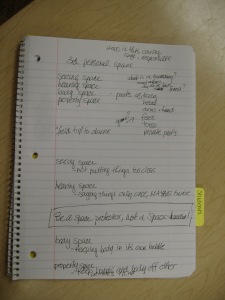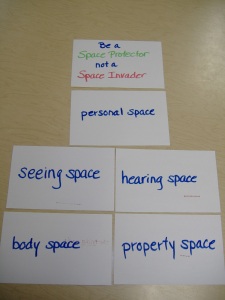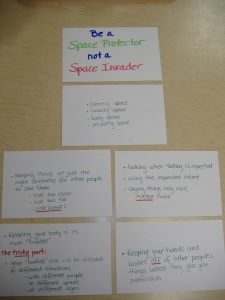 I am just as happy as the next person to be completely prepared well in advance of all groups, classes, individual sessions, presentations, meetings, etc., with copies made, technology tested, and materials arranged. However, the reality of school counseling means that sometimes planning and prep have to happen on the fly. Perhaps an issue has arisen in a particular classroom or grade, and you have to go in to address it on a minute’s notice. Or you find out that an assembly was scheduled without you knowing it and you have to move a class or group to an earlier time. Or a kid is on her way after being asked to leave class because of some behavior that is getting in the way of others’ learning. Yikes! This calls for Guerilla Planning! Guerilla????
I am just as happy as the next person to be completely prepared well in advance of all groups, classes, individual sessions, presentations, meetings, etc., with copies made, technology tested, and materials arranged. However, the reality of school counseling means that sometimes planning and prep have to happen on the fly. Perhaps an issue has arisen in a particular classroom or grade, and you have to go in to address it on a minute’s notice. Or you find out that an assembly was scheduled without you knowing it and you have to move a class or group to an earlier time. Or a kid is on her way after being asked to leave class because of some behavior that is getting in the way of others’ learning. Yikes! This calls for Guerilla Planning! Guerilla????
guerrilla, guerilla [gəˈrɪlə]n
1. (Military)
a. a member of an irregular usually politically motivated armed force that combats stronger regular forces, such as the army or policeb. (as modifier) guerrilla warfare2. (Life Sciences & Allied Applications / Botany) a form of vegetative spread in which the advance is from several individual rhizomes or stolons growing rapidly away from the centre, as in some clovers.
Well, probably some people think of me as irregular, but I am generally unarmed, unless you count sharpies, and not all that politically motivated, at least while at school. I do, however, combat stronger regular forces — like too much to do in too little time, schedules I cannot control, and teachers’ room bathrooms that are always full when I have a nanosecond to visit them. Also, I think vegetative spread might explain what happens with the papers on my desk.
My grad student interns and new counseling colleagues are always interested in how to handle these sometimes daunting situations, and after some guerrilla planning last Thursday I decided that it might be helpful to share my method for handling this particular madness. “You’re so creative!” my first-year counseling partner, Erica, said, when I showed her what I had pulled together in a few minutes for our social thinking group. Yes, thinking creatively is one of my strengths, but I also have 16 years of experience to draw upon and, most importantly, (1) the belief that I can do it and (2) a procedural tactic.
About 20 minutes before our group meeting time, Erica forwarded an email she had received from the speech/language pathologist, asking if it would be possible for us to use the group to help work on the following IEP goal for one of our students:
[Student] will describe and demonstrate to the counselor or SLP what it means to have appropriate physical and emotional boundaries, such as adjusting personal space or topics of conversation based on level of personal aquaintance.
This goal fit perfectly under the umbrella of social thinking, and our group was ready to move on to a new unit. (The group is made up of 3rd and 4th grade students on the autism spectrum and/or with anxiety issues that impact social thinking ability. Erica and I co-facilitate.) While this particular student has the biggest issue with maintaining physical and emotional boundaries, all group members could benefit from focusing on this topic. We decided that rather than having to wait until we had concluded another unit to start addressing the personal space goal, we would go ahead. No time like the present! The clock was ticking.
1.What would be easiest? A book! I couldn’t remember if I had actually ordered the book Personal Space Camp by Julia Cook or if it was still on my wish list (okay, okay, things have been crazy here!), but it turned out that I hadn’t, so reading the book was not going to be the centerpiece of our lesson and activity. (See the Books that Heal Kids review here.) Drat! Plan B.
 |
| A great idea — if I actually had the book! |
2. I got out my notebook and started scribbling. What did we want the kids to understand about personal space? Right now, they might be able to tell you that they should keep their bodies to themselves, and would definitely object if someone else invaded their space in a way they didn’t like. Adults and kids alike have been telling them for years, over and over, to stay in their own space bubble, not to touch people, etc., but they haven’t truly understood or generalized these instructions. The concept needed to be broken down. I thought about some of these kids’ behaviors and scribbled:
- body space — getting too close and touching too much
- property space — touching others’ property without permission
- hearing space — continuing to talk and/or make noise when others want you to stop
- seeing space — holding objects too close to someone else’s face
 |
| Sloppy, but effective. |
3. Because our ultimate goal would be to replace the unexpected behavior of violating other people’s boundaries with the expected behavior of recognizing and respecting boundaries, I wanted to come up with a slogan that would clearly state our goal. I thought of “space invaders” and came up with
Be a space protector, not a space invader.
 |
| Yup, the red marker is bleeding through from the other side. Perfectionism and guerilla planning are not compatible! |
Keeping things at the expected distance for other people to see them:
– not too close
– not too far
– JUST RIGHT!
Talking when talking is expected
Using the expected volume
Saying things only once, MAYBE twice
Keeping your hands and bodies off of other people’s things unless they give you permission
Keeping your body in its own “bubble”
Your “bubble size will be different in different situations
– with different people
– in different spaces
– at different ages
5. I stacked the cards and, remembering my “fences” idea, grabbed some plastic fence from my sand tray materials, and surrounded the cards. I knew the kids would never be able to keep their hands off of this, what with the surprise of seeing a fence, the colorful lettering, and cool words like “space protector” and “space invader.” It would be the perfect way to start a conversation about boundaries.
 |
| Time it took before someone touched this: about 4 nanoseconds. |
Boom! Fifteen minutes later, and ready for the group, with scribbled ideas that will form the basis of lessons and activities in following sessions. And it went amazingly well! We worked with the fact that almost everyone had been unable to keep from touching things, read and discussed the cards (after working out how to be fair about it all), and they colored space invaders and put a red circle/slash over them. In upcoming groups we will go more in-depth on each kind of “space,” will make space protector pictures, perhaps with photos of their heads on drawn bodies, and will explore how we have different expectations about how close/far different parts of our bodies should stay from other people. I’m thinking that this may turn into a game of some sort. I will refer back to my scribbled notebook page, but will probably have more time when I plan the other sessions. I hope.
 |
| Space Invader image from Superflex: A Superhero Social Thinking Curriculum. More on this fabulous resource soon! |
Things to remember when guerilla planning:
1. Ask yourself, “What do I want the kids to know when they
leave?” Start there and work backwards.
there’s no time for printing and copying. Use what’s at hand.
3. It is possible to create materials with kids as you go.
Sometimes it even benefits their learning process. (The kids
could have helped make the cards, fetched the fence pieces,
or built a Lego fence.)
something meaningful in a short period of time. It’s a great
opportunity to practice letting go of perfectionism and
insecurities that can get in your way.
materials for future groups/classes if that makes you feel
better. (Sometimes it just does!)


Trackbacks/Pingbacks